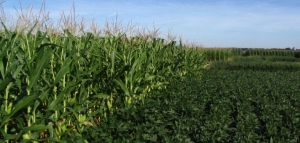Understanding Changes in Raccoon River Nitrate
May 17, 2016

IIHR’s water-quality monitoring network has generated interesting data that contradicts some widely-held beliefs regarding corn and soybeans and their impact on nitrate in Iowa’s streams.
As Iowa farmers have planted more acres of corn to meet the demand driven by the corn-based ethanol industry, many models predicted that nitrate concentrations in Iowa streams would increase accordingly. However, recent IIHR research based on water monitoring and published in the Journal of Soil and Water Conservation casts doubt on these predictions.
IIHR—Hydroscience & Engineering researchers Chris Jones, Keith Schilling, and Kung-Sik Chan, along with colleagues at the Iowa Soybean Association, evaluated water monitoring results from more than 7,000 water samples collected in the Raccoon River watershed of Central Iowa from 1999–2014. The team also had access to fertilization data for 700 fields in the watershed. The information led the researchers to believe that nitrate levels are less dependent on corn production acres than previously thought. As more acres were planted in corn (and fewer in soybeans), fertilizer application increased a whopping 24 percent in the watershed. Interestingly, river nitrate did not increase and may have even decreased slightly at most watershed locations.
“One might conclude from these data that fertilizer use efficiency improved,” Jones says. “But we believe that was not the case. The amount of nitrogen leaving the watershed in the harvested grain actually declined a little bit during our study.”
Where did the additional fertilizer nitrogen go? Jones says that clues can be found in the differences between corn and soybean plant growth, soil chemistry, and the decay of stalks and other crop residues. Nitrate-nitrogen can accumulate and be immobilized in the soil under corn. On the other hand, dead and decomposing soybean plants can increase the amount of nitrate in the soil vulnerable to loss (more so than cornstalks), especially if accompanied by fall tillage. Also, there is evidence that tile discharge may increase under soybean fields as a result of reduced plant evapotranspiration compared to corn. Therefore, because tile nitrate concentrations are similar under both corn and soybean, more tile flow under soybean can mean more nitrate delivered to streams. As a result, Jones says he and his colleagues believe that declining soybean acres may have reduced the cropped areas most vulnerable to nitrate loss, more than compensating for the increased fertilizer inputs on corn acreage.
Subsequent research conducted by Schilling, Jones, and Gabriele Villarini also supports this idea. A mathematical model developed by Villarini shows Raccoon River nitrate is dependent upon the previous year’s soybean area.
“Understanding this process could prove important as we try to reduce the loss of nutrients to Iowa streams as part of the Iowa Nutrient Reduction Strategy,” Jones says. “We know we can’t just focus on fertilization of corn. We need a systems approach to improve water quality. It also demonstrates the power of monitoring water quality. Without this data, we could easily have missed this important and counter-intuitive conclusion.” IIHR is committed to collecting this essential water-quality data and making it easily available to Iowans through its web tool, the Iowa Water-Quality Information System (http://iwqis.iowawis.org).



